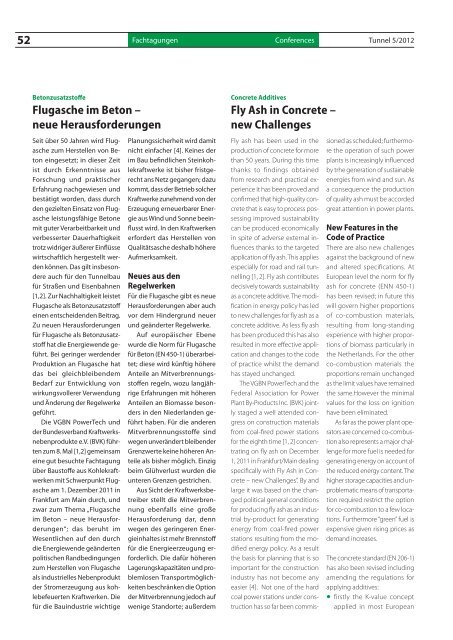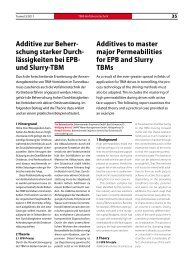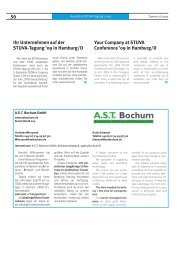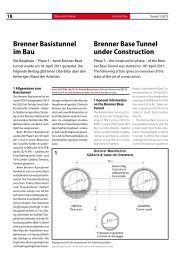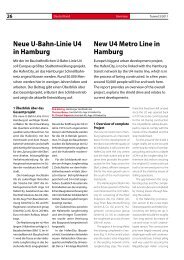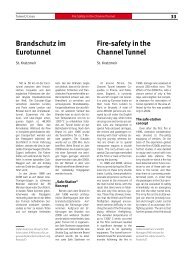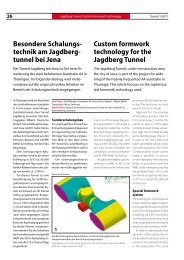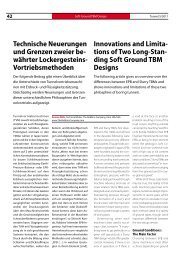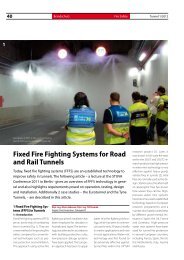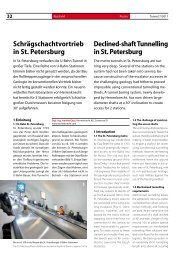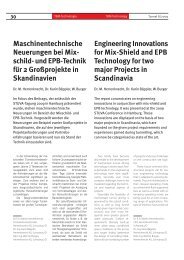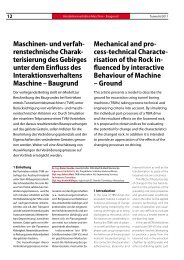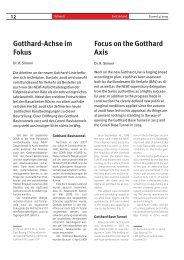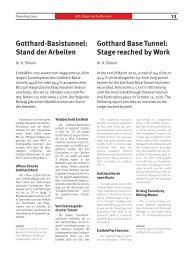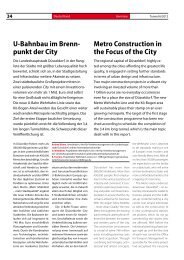Deutsches tunnel-Forum 2012
Deutsches tunnel-Forum 2012
Deutsches tunnel-Forum 2012
Sie wollen auch ein ePaper? Erhöhen Sie die Reichweite Ihrer Titel.
YUMPU macht aus Druck-PDFs automatisch weboptimierte ePaper, die Google liebt.
52 Fachtagungen<br />
Conferences Tunnel 5/<strong>2012</strong><br />
Betonzusatzstoffe Concrete Additives<br />
Flugasche im Beton –<br />
neue Herausforderungen<br />
Seit über 50 Jahren wird Flugasche<br />
zum Herstellen von Beton<br />
eingesetzt; in dieser Zeit<br />
ist durch Erkenntnisse aus<br />
Forschung und praktischer<br />
Erfahrung nachgewiesen und<br />
bestätigt worden, dass durch<br />
den gezielten Einsatz von Flugasche<br />
leistungsfähige Betone<br />
mit guter Verarbeitbarkeit und<br />
verbesserter Dauerhaftigkeit<br />
trotz widriger äußerer Einflüsse<br />
wirtschaftlich hergestellt werden<br />
können. Das gilt insbesondere<br />
auch für den Tunnelbau<br />
für Straßen und Eisenbahnen<br />
[1,2]. Zur Nachhaltigkeit leistet<br />
Flugasche als Betonzusatzstoff<br />
einen entscheidenden Beitrag.<br />
Zu neuen Herausforderungen<br />
für Flugasche als Betonzusatzstoff<br />
hat die Energiewende geführt.<br />
Bei geringer werdender<br />
Produktion an Flugasche hat<br />
das bei gleichbleibendem<br />
Bedarf zur Entwicklung von<br />
wirkungsvollerer Verwendung<br />
und Änderung der Regelwerke<br />
geführt.<br />
Die VGBN PowerTech und<br />
der Bundesverband Kraftwerksnebenprodukte<br />
e.V. (BVK) führten<br />
zum 8. Mal [1,2] gemeinsam<br />
eine gut besuchte Fachtagung<br />
über Baustoffe aus Kohlekraftwerken<br />
mit Schwerpunkt Flugasche<br />
am 1. Dezember 2011 in<br />
Frankfurt am Main durch, und<br />
zwar zum Thema „Flugasche<br />
im Beton – neue Herausforderungen“;<br />
das beruht im<br />
Wesentlichen auf den durch<br />
die Energiewende geänderten<br />
politischen Randbedingungen<br />
zum Herstellen von Flugasche<br />
als industrielles Nebenprodukt<br />
der Stromerzeugung aus kohlebefeuerten<br />
Kraftwerken. Die<br />
für die Bauindustrie wichtige<br />
Planungssicherheit wird damit<br />
nicht einfacher [4]. Keines der<br />
im Bau befindlichen Steinkohlekraftwerke<br />
ist bisher fristgerecht<br />
ans Netz gegangen; dazu<br />
kommt, dass der Betrieb solcher<br />
Kraftwerke zunehmend von der<br />
Erzeugung erneuerbarer Energie<br />
aus Wind und Sonne beeinflusst<br />
wird. In den Kraftwerken<br />
erfordert das Herstellen von<br />
Qualitätsasche deshalb höhere<br />
Aufmerksamkeit.<br />
Neues aus den<br />
Regelwerken<br />
Für die Flugasche gibt es neue<br />
Herausforderungen aber auch<br />
vor dem Hindergrund neuer<br />
und geänderter Regelwerke.<br />
Auf europäischer Ebene<br />
wurde die Norm für Flugasche<br />
für Beton (EN 450-1) überarbeitet;<br />
diese wird künftig höhere<br />
Anteile an Mitverbrennungsstoffen<br />
regeln, wozu langjährige<br />
Erfahrungen mit höheren<br />
Anteilen an Biomasse besonders<br />
in den Niederlanden geführt<br />
haben. Für die anderen<br />
Mitverbrennungsstoffe sind<br />
wegen unverändert bleibender<br />
Grenzwerte keine höheren Anteile<br />
als bisher möglich. Einzig<br />
beim Glühverlust wurden die<br />
unteren Grenzen gestrichen.<br />
Aus Sicht der Kraftwerksbetreiber<br />
stellt die Mitverbrennung<br />
ebenfalls eine große<br />
Herausforderung dar, denn<br />
wegen des geringeren Energieinhaltes<br />
ist mehr Brennstoff<br />
für die Energieerzeugung erforderlich.<br />
Die dafür höheren<br />
Lagerungskapazitäten und problemlosenTransportmöglichkeiten<br />
beschränken die Option<br />
der Mitverbrennung jedoch auf<br />
wenige Standorte; außerdem<br />
Fly Ash in Concrete –<br />
new Challenges<br />
Fly ash has been used in the<br />
production of concrete for more<br />
than 50 years. During this time<br />
thanks to findings obtained<br />
from research and practical experience<br />
it has been proved and<br />
confirmed that high-quality concrete<br />
that is easy to process possessing<br />
improved sustainability<br />
can be produced economically<br />
in spite of adverse external influences<br />
thanks to the targeted<br />
application of fly ash. This applies<br />
especially for road and rail <strong>tunnel</strong>ling<br />
[1, 2]. Fly ash contributes<br />
decisively towards sustainability<br />
as a concrete additive. The modification<br />
in energy policy has led<br />
to new challenges for fly ash as a<br />
concrete additive. As less fly ash<br />
has been produced this has also<br />
resulted in more effective application<br />
and changes to the code<br />
of practice whilst the demand<br />
has stayed unchanged.<br />
The VGBN PowerTech and the<br />
Federal Association for Power<br />
Plant By-Products Inc. (BVK) jointly<br />
staged a well attended congress<br />
on construction materials<br />
from coal-fired power stations<br />
for the eighth time [1, 2] concentrating<br />
on fly ash on December<br />
1, 2011 in Frankfurt/Main dealing<br />
specifically with Fly Ash in Concrete<br />
– new Challenges”. By and<br />
large it was based on the changed<br />
political general conditions<br />
for producing fly ash as an industrial<br />
by-product for generating<br />
energy from coal-fired power<br />
stations resulting from the modified<br />
energy policy. As a result<br />
the basis for planning that is so<br />
important for the construction<br />
industry has not become any<br />
easier [4]. Not one of the hard<br />
coal power stations under construction<br />
has so far been commis-<br />
sioned as scheduled; furthermore<br />
the operation of such power<br />
plants is increasingly influenced<br />
by trhe generation of sustainable<br />
energies from wind and sun. As<br />
a consequence the production<br />
of quality ash must be accorded<br />
great attention in power plants.<br />
New Features in the<br />
Code of Practice<br />
There are also new challenges<br />
against the background of new<br />
and altered specifications. At<br />
European level the norm for fly<br />
ash for concrete (ENN 450-1)<br />
has been revised; in future this<br />
will govern higher proportions<br />
of co-combustion materials,<br />
resulting from long-standing<br />
experience with higher proportions<br />
of biomass particularly in<br />
the Netherlands. For the other<br />
co-combustion materials the<br />
proportions remain unchanged<br />
as the limit values have remained<br />
the same.However the minimal<br />
values for the loss on ignition<br />
have been eliminated.<br />
As far as the power plant operators<br />
are concerned co-combustion<br />
also represents a major challenge<br />
for more fuel is needed for<br />
generating energy on account of<br />
the reduced energy content. The<br />
higher storage capacities and unproblematic<br />
means of transportation<br />
required restrict the option<br />
for co-combustion to a few locations.<br />
Furthermore “green” fuel is<br />
expensive given rising prices as<br />
demand increases.<br />
The concrete standard (EN 206-1)<br />
has also been revised including<br />
amending the regulations for<br />
applying additives:<br />
• firstly the K-value concept<br />
applied in most European


